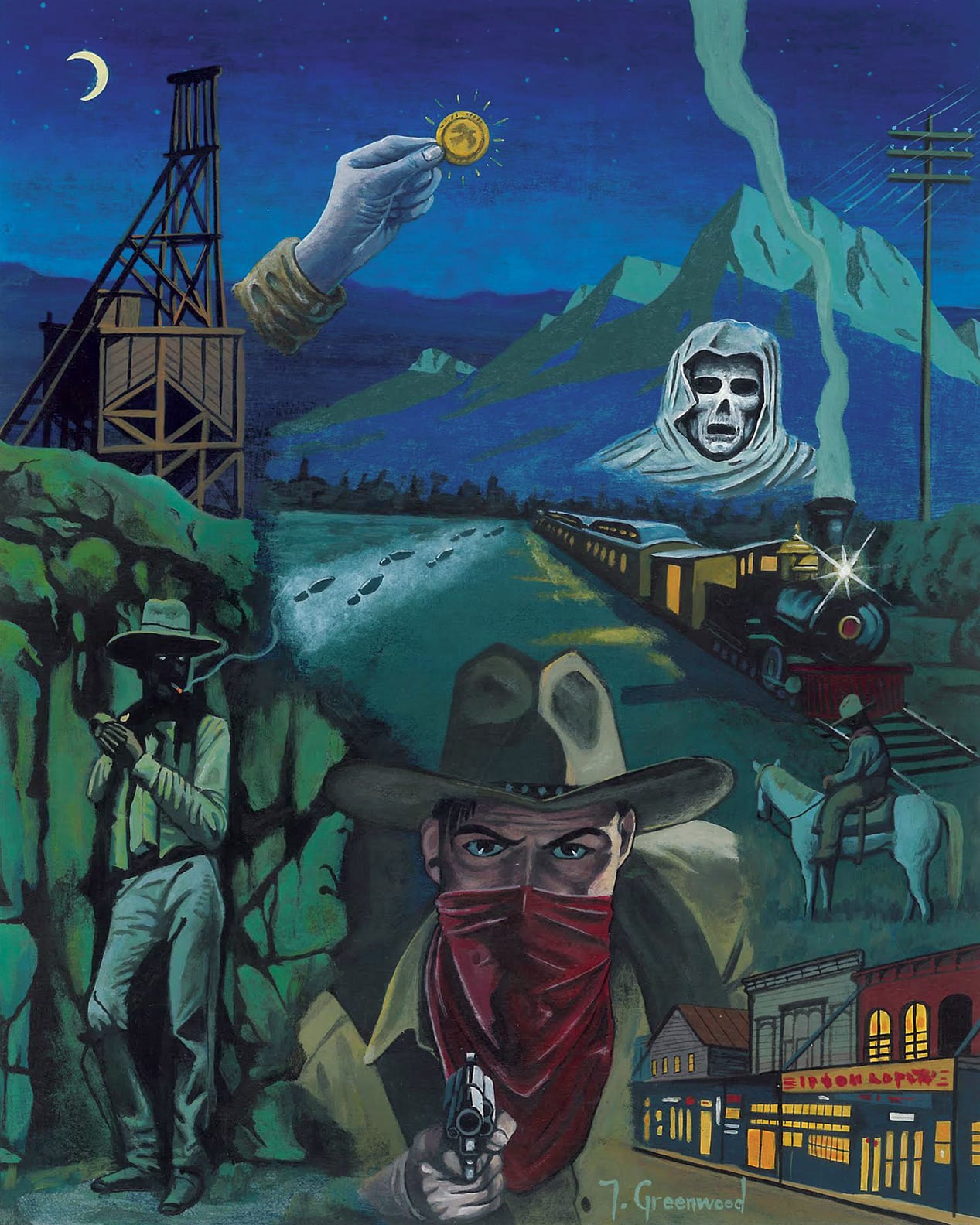
25 Jun Verdi’s Historic Train Heist
In November 1870, bandits pulled off the first train robbery in the American West
Frank Mitchell, a seasoned Wells Fargo guard, was hunkered down with his partner in the express car of the Overland Express heading east from San Francisco when he heard a knock on the door.
Mitchell and his partner were guarding a vast trove of precious cargo—$41,800 worth of $20 gold coins and silver bullion, or the equivalent of $2.2 million in today’s dollars. The cache was on its way to Virginia City so the owners of the mining operation at the Comstock Lode in Virginia City could make payroll and keep pulling silver out of the surrounding hills at record pace.
It was November 5, 1870, near the midnight hour. A light snow had fallen in the days before. The air was frigid and there was little moonlight.
An hour before, the Overland Express had stopped at Truckee long enough for the passengers to disembark and satiate their appetite and slake their thirst before retiring to their cabins for the night.
Naturally, Mitchell and his partner stayed behind with their charge. They were on their way to Reno, where a veritable regiment of Wells Fargo guards were ready to accompany the precious metals south to Virginia City.
But just a few minutes after leaving Verdi, the train suddenly stopped. The inexplicable standstill was followed by a knock on the door.
“Who’s there?” Mitchell asked.
“Marshall,” came the gruff reply.
Assuming it was Conductor D.G. Marshall, Mitchell opened the door only to be greeted by the muzzle of a sawed-off double-barrel shotgun at the end of one imposing masked bandit. The bandit entered the room, keeping the two men covered before he was joined by several of his masked associates.
They immediately pried open the tops of the strongboxes and removed most of the gold while leaving the silver and a few gold bars, apparently identifying the bullion as too cumbersome to carry away.
The bandits stuffed the gold coins into sacks made from the tops of boots and tossed the loot into the surrounding brush. Exiting the train, the five masked men gathered the sacks, distributed them among themselves, packed them onto the saddles of their horses and, taking divergent paths, vanished into the night.
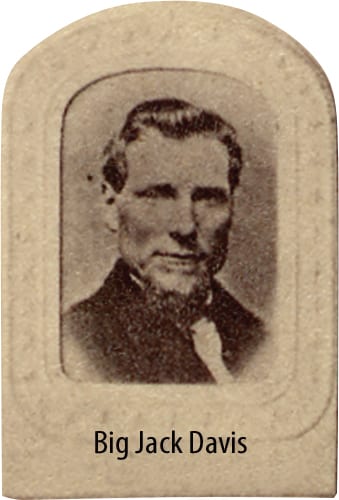
Courtesy Special Collections Department, University of Nevada, Reno Libraries
Big Jack
Big Jack Davis was one of the luminaries of Virginia City during the Silver Rush.
By the time Davis was running his ore stamp mill, working as a mining recorder and providing other legitimate services to the large mining operation at the Comstock Lode, Virginia City was booming. People flocked from all parts of the country after miners discovered the enormous vein of silver in the hills just east of Lake Tahoe.
Davis originally journeyed to Virginia City seeking fortune as a miner. Quickly discovering he was more constitutionally suited to above-ground work, he carved out a niche in the local economy and, more importantly, employed a gregarious and ingratiating nature in installing himself into the social milieu.
But Davis was harboring a significant secret. The smooth businessman was moonlighting as an avid, well-practiced and moderately successful stagecoach robber.
Often using the cover of night, Davis routinely enlisted a revolving cast of unsavory criminals to help him lift gold and silver from various mines that cropped up after the California Gold Rush.
Northern Nevada proved an ideal location for a budding outlaw as stagecoach routes traversed the region.
Davis was also in an enviable position in that he could use his ore-stamping mill to recast stolen metal and avoid detection. While Davis’ diverse business pursuits, both licit and otherwise, earned him a decent living, Big Jack, as he was called, had more ambitious designs.
The era of the railroad had come to the West. The golden spike, driven into the ground by Leland Stanford in Utah on May 10, 1869, represented the completion of the First Transcontinental Railroad in the United States.
The newly completed transportation network meant mine operators, banks, financial institutions and other businesses had a more secure and efficient means of conveying goods back and forth. Sending vast troves of gold by train was on the increase, while stagecoaches were left with less lucrative freight, like the mail.
For stagecoach robbers, this technological paradigm shift impinged upon their business prospects. But Davis didn’t see the new order of things in the West as an impediment, but a new sort of opportunity.
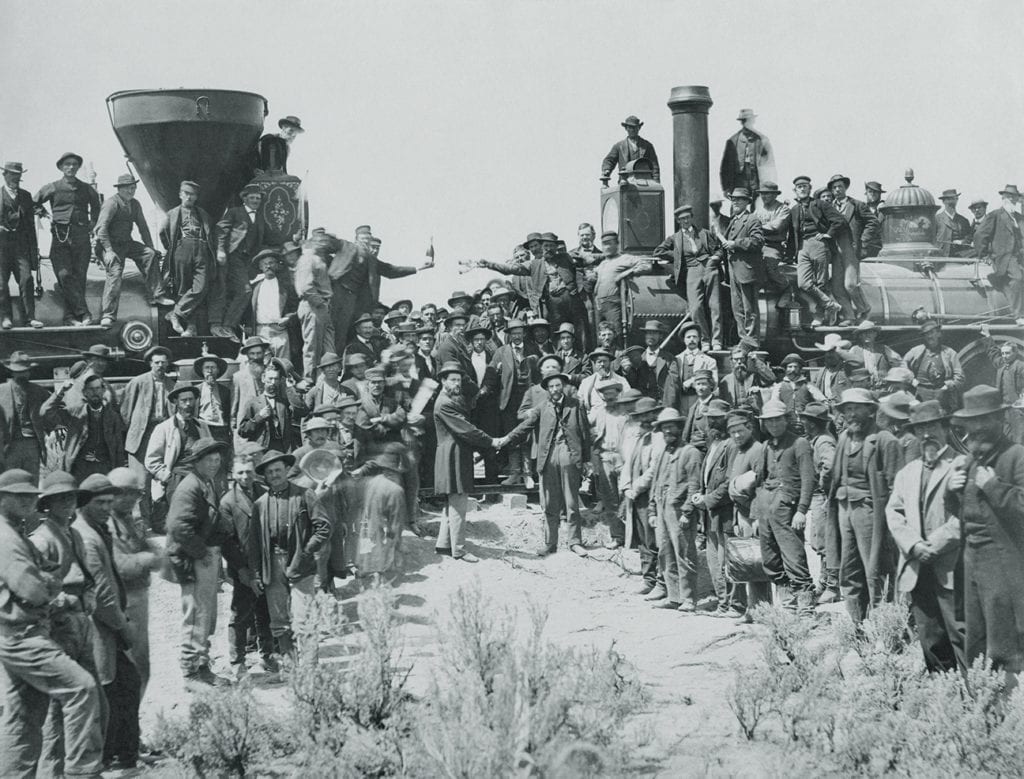 The ceremony for the driving of the golden spike at Promontory Summit, Utah, in 1869 marked the completion of the First Transcontinental Railroad in the United States. Less than a year and a half later, a gang of bandits committed the first train robbery in the American West near Verdi, photo courtesy Yale University Libraries
The ceremony for the driving of the golden spike at Promontory Summit, Utah, in 1869 marked the completion of the First Transcontinental Railroad in the United States. Less than a year and a half later, a gang of bandits committed the first train robbery in the American West near Verdi, photo courtesy Yale University Libraries
Train Robbers
Train robbery wasn’t exactly a new concept by the time Davis started to plan his heist, but it wasn’t old hat either.
The Reno brothers famously robbed a train in Indiana in 1866, four years before the Verdi train robbery, but both incidents occurred well before the likes of Jesse James and Butch Cassidy were haunting railroad lines across the West in the 1890s.
So when Davis pitched some criminals like John Squires, James Gilchrist, Tilton Cockerill and R.A. Jones on a train robbery at Verdi, one could understand their skepticism.
The complexities of a train robbery entailed overcoming several armed guards, potentially dealing with passengers, the conductor, the engineer, brakemen and other railroad employees, all of which made robbing one-shotgun stagecoaches look straightforward and simple.
But Davis had plans to deal with each component and, after asking around, came up with a few hired guns to help hatch the first train robbery in the American West.
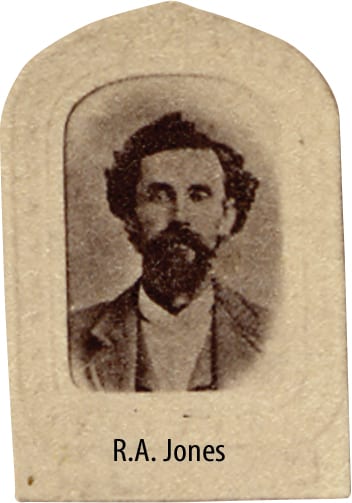
Courtesy Special Collections Department, University of Nevada, Reno Libraries
The Heist
The heist itself, as conceived by Davis, was flawlessly executed and could be considered a rousing success by nearly any metric.
John Chapman, a former Sunday school superintendent, was the gang’s man in San Francisco. It was his job to observe the loading of the gold and silver into the express train and give the rest of the gang the high sign when the goods were underway. On November 4, Chapman sent a telegram to Sol Jones, appointed by Davis to await word in Reno.
“Send me sixty dollars without fail,” the telegram read. It was a cipher for “Be on hand without fail.”
Jones relayed the message to five gang members hiding out in an old tunnel in the Peavine Mountains north of Verdi.
The game was on. The bandits immediately headed to Verdi, the small town about 20 miles east of Truckee.
The Central Pacific Overland Express typically made a brief, uneventful stop at Verdi after leaving Truckee and before docking at Reno. Verdi, re-named by railroad baron Charles Crocker after Italian opera singer Giuseppe Verdi, is located along the Truckee River near the California–Nevada border.
When the Overland Express reached the hamlet around midnight, no one of note boarded the train. It wasn’t until it began leaving the station that the conductor, D.G. Marshall, noticed a couple stragglers boarding the back of the train as it steamed out of Verdi.
Thinking it was late-arriving passengers, Marshall made his way to the back of the train where he encountered the gunmen, who brandished their weapons and kept the conductor covered.
A third bandit alighted the train, immediately heading to the express car where the gold was stored.
Meanwhile, the fourth and fifth bandits infiltrated the engine room, where Henry Small and his fireman were directing the locomotive down the eastern escarpment of the Sierra. They told Small to apply the brakes, which was a signal for the two bandits at the back to move forward and disconnect the passenger cars from the engine, leaving the majority of the train powerless.
The move also had the added benefit of cutting down crowd control responsibilities, essentially leaving five bandits to cover four men divested of any weapons.
Farther down the track, Davis had taken care to lay an obstruction across the tracks near Hunter’s Crossing, a few miles east of Verdi. The thieves had also cut the telegraph wires to ensure no one could send out the alarm.
Once the train was halted, the bandits gained access to the express car, subdued the Wells Fargo agents, grabbed the approximately $40,000 in gold coins and made haste in different directions.
Meanwhile, Marshall, the conductor, guided his engineless passenger train down the grade before encountering the recently plundered express car along with the engine. Small and his fireman were removing brush from the tracks when Marshall arrived.
After clearing the way, the Overland Express pulled into Reno minus its precious cargo, but only 30 minutes late.
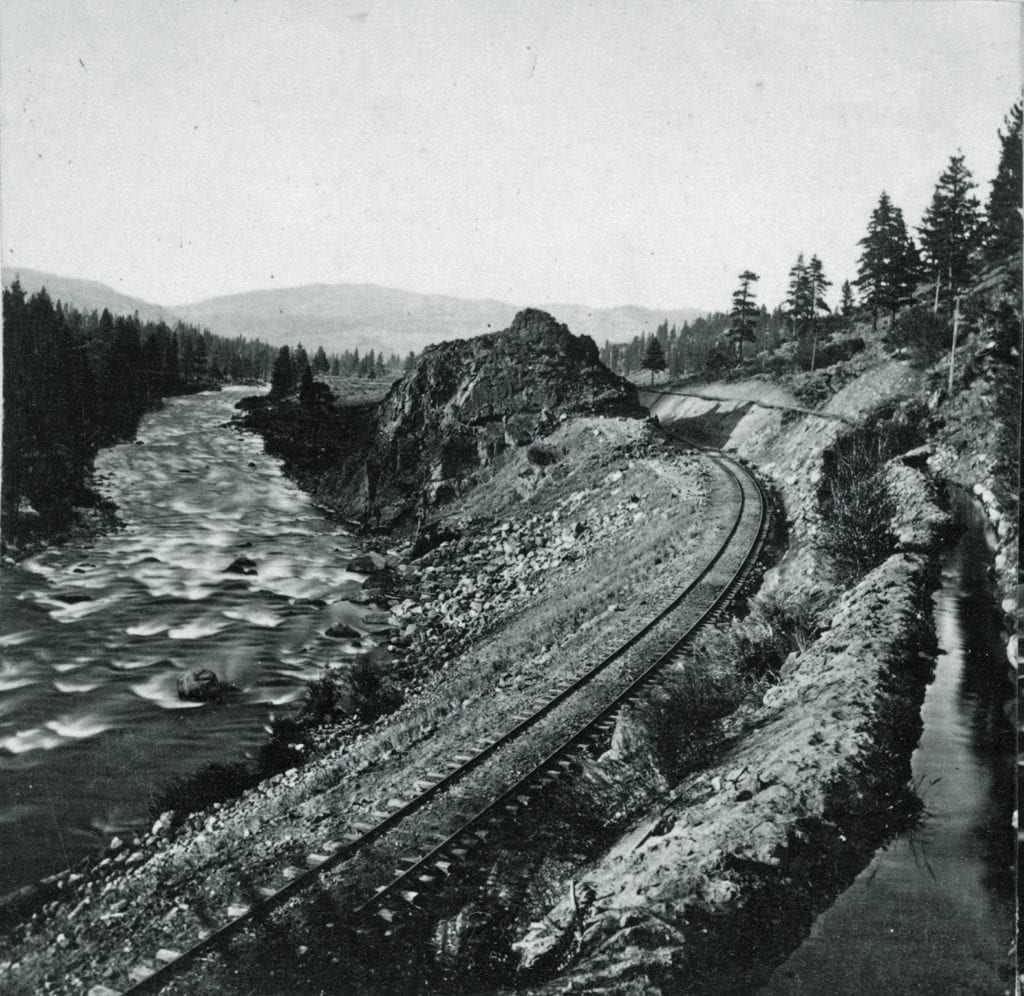 A view of the Truckee River and railroad tracks just west of Verdi, near the location of the first train robbery in the American West in November 1870, photo courtesy Library of Congress Prints and Photographs Division
A view of the Truckee River and railroad tracks just west of Verdi, near the location of the first train robbery in the American West in November 1870, photo courtesy Library of Congress Prints and Photographs Division
Detective Work
Washoe County Sheriff Charlie Pegg received the news about the great train heist first thing the next morning. Word spread to the newspapers as well, and the nation soon got wind of the robbery.
“All talk upon the streets today is of the great robbery on the railroad between Verdi and Reno last night,” read the lead sentence of Nevada’s Territorial Enterprise.
Pegg and his deputy, James Kinkead, assuming the thieves would use a trail through the mountains that would drop them into Carson City, immediately saddled up and pursued a shortcut to head them off.
The gambit proved fruitless and the officers backtracked, convinced by the lack of footprints in the recently fallen snow that they had yet to catch the scent.
Once back in Reno, the two officers learned an entire squadron of Wells Fargo detectives, railroad officials and regular citizens faced similar dead ends tracking down the thieves after pursuing a clue they incorrectly felt to be fail-safe.
The next day, Pegg and Kinkead repaired to the scene of the crime, where Kinkead employed some good old-fashioned detective work to land their first definitive clue. A footprint with a narrow heel—a fashionable choice for gamblers, but not laborers—was found in proximity to the train tracks.
“No laboring man or railroad employee ever wore that boot,” Kinkead later wrote in a memoir of the robbery and its aftermath, which was found after his death.
So Kinkead searched in either direction along the tracks for other boot prints of a similar shape hoping to locate the track the thieves used to escape the canyon. About a mile west of the crime scene, another print with a narrow heel was discovered.
The thieves had attempted to escape detection by walking along the tracks for the better part of a mile. They abruptly broke northwest through the Truckee River, steering their steeds out of the canyon along Dog Valley Creek heading back into California. Kinkead followed the tracks up Dog Valley Hill and into Sardine Valley, directly south of what is now Stampede Reservoir.
Sardine Valley House
Big Jack Davis and his merry band of thieves may have met an entirely different fate had it not been for the intercession of the wife of Nicholas Pearson, proprietor of the Sardine Valley House.
Mrs. Pearson, not her husband, was the one to check in two travelers in the early morning hours the night of the robbery. Later, a third man arrived who, once checked in, appeared to confer in hushed tones with the other travelers in the hallway.
Pearson thought the men were behaving suspiciously.
Arriving late, separately, and going about their business with a general air of unease, all prompted Pearson’s qualms. But Pearson was unaware of the robbery at that point so thought nothing of it until the following morning.
The first two men left at the crack of daylight, leaving the third behind. By this time, Pearson had caught wind of the robbery and began to make connections between it and the behavior of her guests.
When a group of hunters from Truckee arrived, the suspicious man mistook them for officers and sprinted quickly to the barn. Legend has it that Pearson, peering through a knothole in the boards, saw the man hiding the gold coins in his boot.
Whatever the case, she conveyed her suspicions to James Burke, hunter and Truckee resident, who with his compatriots immediately apprehended the man they suspected had taken part in the previous night’s caper.
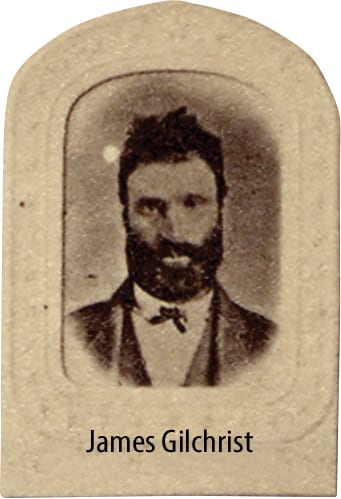
Courtesy Special Collections Department, University of Nevada, Reno Libraries
Sure enough, James Gilchrist, a former carpenter and criminal novice, confessed his role and surrendered. Soon after he was arrested and transported to jail, Kinkead, who had spent the morning following the tracks from Verdi up into the hills, arrived and received a complete description of two of the other two bandits—E.B. Parsons and John Squires.
Pursuing their trail, Kinkead found Parsons sleeping in a Sierra Valley hotel, stole his gun from under his pillow and, with the help of a few other lawmen, apprehended the fugitive without incident.
Kinkead was familiar with Squires—a well-known career criminal with a considerable rap sheet. He knew that Squires had a brother, Joe, an honest blacksmith who lived in nearby Sierraville. Kinkead and his men set out briskly for the town and eventually came upon Squires passed out in his brother’s guest room, apparently exhausted from the rigors of the previous night’s enterprise.
Once again able to disarm the bandit as he slept, Kinkead and his men took Squires into custody.

Courtesy Special Collections Department, University of Nevada, Reno Libraries
In the meantime, while locked up in the Truckee jail, Gilchrist sang like a canary, telling law enforcement in detail about the scheme and its participants. Gilchrist was set free in exchange for his testimony against his cohorts.
Davis was arrested in Virginia City, but his ability to ingratiate himself into the local business community proved invaluable. Unlike Squires, who got sent up for 24 years, and three of the other gang members, who got between 18 and 22 years, Davis only was sentenced to only 10 years, despite being the brains, capital and a fair bit of muscle behind the heist.
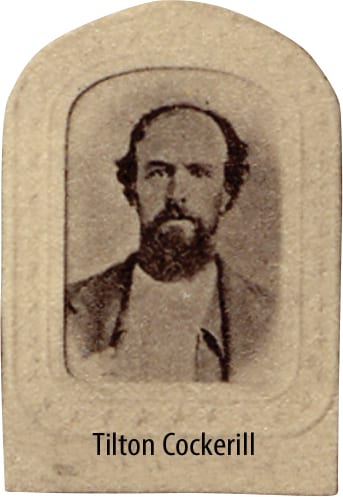
Courtesy Special Collections Department, University of Nevada, Reno Libraries
Part of it was that other participants, like Tilton Cockerill, who was already convicted for armed robbery, had well-established criminal pasts. The exception to this was John Chapman, the Sunday school superintendent, who sent the telegram from San Francisco. His trial was quite the event in Reno, with his lawyer repeatedly proclaiming his client’s innocence and saying the state of Nevada lacked the necessary jurisdiction.
Chapman himself maintained his innocence even after his conviction, but the Western Union officer who sent the telegram swore emphatically that Chapman was the man who sent the message. The young man was sentenced to 18 years for his role, despite never so much as brandishing a gun or touching a single piece of ill-gotten gold.

Courtesy Special Collections Department, University of Nevada, Reno Libraries
Outlaw Till the End
Coming only 18 months after the establishment of the first transcontinental railroad system in the nation, the Verdi robbery served as a template for later train-robbing criminals like Jesse James. Those later bandits have since been inextricably interwoven into the folklore of America.
While Davis’ story does not have the resonance of James or Butch Cassidy, he was their forefather.
Davis went to jail and a couple years into his sentence was witness to a massive prison break. Despite three of the other members of his gang escaping the prison, Davis not only stayed put, but helped prison guards quell the insurrection. He also provided information about the escapees.
For his efforts he was released early, after serving only five years of his 10-year sentence. His standing in Virginia City also helped secure the truncated sentence.
Big Jack could have returned to regular society, kept his head down and lived a long, prosperous life. But that’s not what happened. He simply could not put down his ingrained vocation and what appears to have been a passion—robbing stagecoaches.
On September 13, 1877, seven years after the great train robbery and two years after his release from the Nevada State Penitentiary, Davis was shot and killed while attempting to rob a stagecoach outside Warm Springs, Nevada.
The story for the most part ends there. However, treasure hunters throughout the decades note that law enforcement officers were able to recover all but $3,000 worth of gold coins taken by the bandits.
Several of the gang members told police where they buried portions of their loot, but some held out.
Somewhere along the Truckee River, up Dog Valley Creek, in Six-Mile Canyon east of Virginia City or along the slopes of the Peavine Mountains may lie enough gold to make up a pretty retirement fund for anyone lucky enough to hit paydirt.
One legend, passed down through the generations, holds that the ghost of Big Jack Davis continues to protect his treasure and will appear as a white screaming phantom and ceaselessly haunt anyone with the audacity to try to pilfer his gold.
Matthew Renda is a Santa Cruz–based writer and history fan. To date, he has never robbed a train.




No Comments